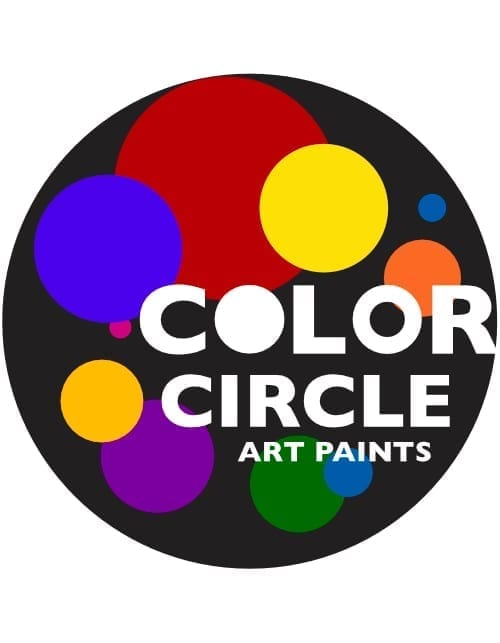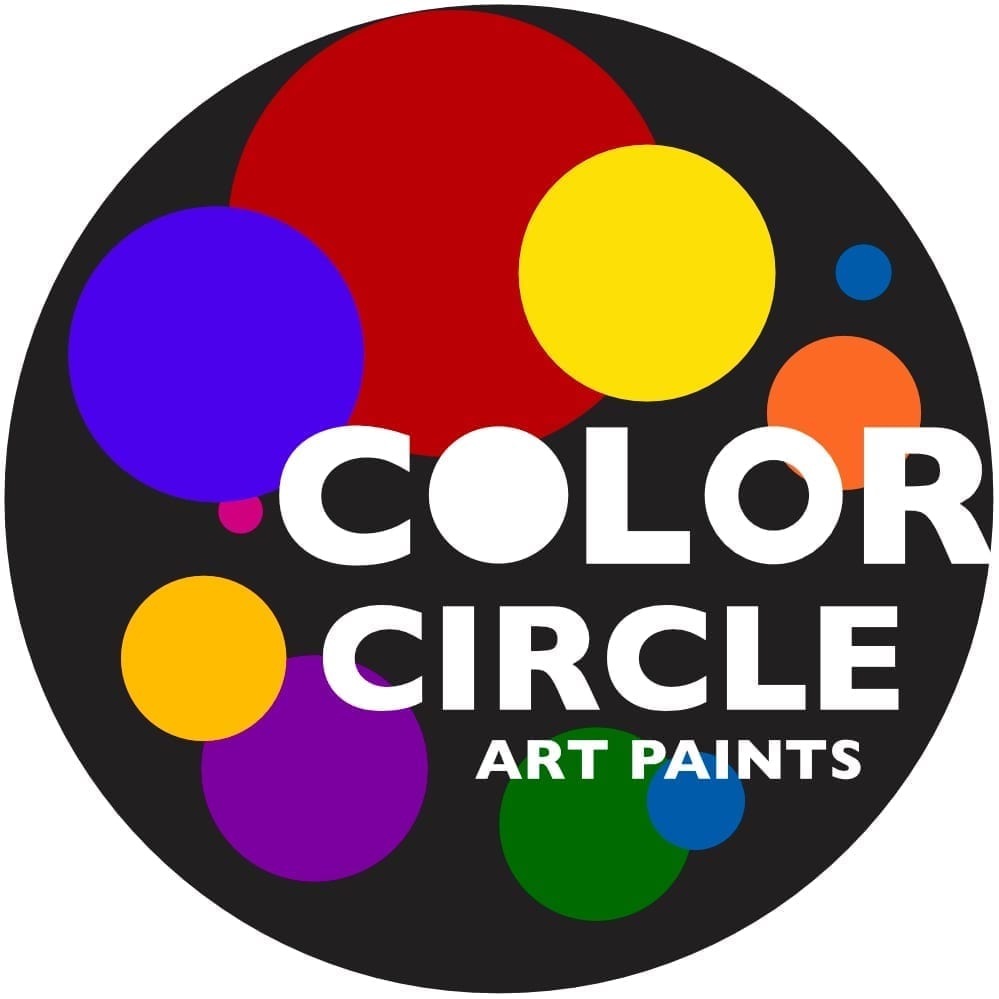One color system for many painting techniques
With COLOR CIRCLE ART PAINTS, you can paint on most surfaces using a wide variety of techniques:
Glazing like watercolor, opaque like gouache (when using opaque white from our range), impasto (thick layers) by adding extremely voluminous materials such as plaster, wood flour, textured materials (available in a wide variety from specialist dealers), etc.
Main techniques
Watercolor
The watercolor painting technique is classically understood as painting with pigments that have been rubbed with gum arabic. It is based on the paper as the painting support. The white of the paper forms the highlights, is left out or is slightly tinted with thin glazes (layers). Opaque white is not normally used.
Glazes in the same shade or in other colors on top of each other produce optical mixed colors that can develop a wonderful luminosity. Painted wet on wet, cloudy structures and color combinations result.
The pigments in watercolors should be as fine and transparent as possible. However, iron oxides such as yellow and red ochre, for example, are opaque. Painters must therefore know exactly which colors are transparent or opaque.
Color Circle Art Paints, on the other hand, are highly transparent and colorful throughout.
Watercolor paints can only be used on paper supports, as the gum arabic only adheres to them.
Today, however, specially processed, partially re-soluble acrylic resin is also used for this purpose.
Color Circle Art Paints adhere excellently to most surfaces. For information, see substrate materials.
The watercolor technique is always painted without opaque white.
The watercolor coloring is also known as the most difficult technique of all.
However, we believe that this technique is the only way to discover the world of color and create fascination!
With opaque paints (gouache), the opaque white plays a dominant role, which always distorts the color effect.
With COLOR CIRCLE ART PAINTS, YOU have it in your hands to discover color in all its nuances and laws, as you can produce everything from watercolors to opaque paints yourself – with the same materials, only supplemented by our opaque white.
Acrylic painting
Acrylic paints are based on synthetically produced acrylic resins, which have been known since 1903 and have found a wide range of applications today: Acrylic glass (Plexiglas), dispersion paints for architectural coatings, car paints, artists‘ paints, gouache paints, adhesives, etc.
Acrylic resins are characterized by high light fastness, high transparency, high elasticity and resistance to aging (yellowing).
They are tailor-made for the respective application.
The acrylic resin used in COLOR CIRCLE ART PAINTS acrylic paints also has a limited re-solubility with water.
Excellent re-solubility with technical alcohol (methylated spirits).
Thanks to the controllable, synthetic production process, the uniformity of the paint from batch to batch is guaranteed, in contrast to natural binders, which are subject to strong fluctuations in quality.
Gouache
Opaque paints made from Color Circle. Pictures painted with opaque colors are also called gouache paintings.
Opaque white, fillers and possibly structural materials give the colors “body”.
This makes it possible to apply thick, impasto layers and also to paint over parts of the picture.
Painting materials that no longer allow the background to show through are referred to as opaque or covering.
COLOR CIRCLE ART PAINTS is an easy way to make your own opaque paints:
Mix the colored paint with Opaque white 16/17
Caution: Add a little Opaque White 16/17, otherwise the color will very quickly become a light pastel color.
The opaque white, which is usually made from titanium dioxide (not to be confused with the poison dioxin!), should cover the background.
It is used to prime surfaces or make a transparent paint opaque.
The mixing ratio between pigment and opaque white determines whether the finished color is pastel-like or has a strong solid tone.
With COLOR CIRCLE, YOU determine the colorfulness of the opaque paint!
To do this, take a LITTLE Opaque white 16 from the bottle with the white spatula and add paint drop by drop to the palette.
You can mix with a brush.
Only add more opaque white or paint when the paint is very well mixed, otherwise the shade will appear too light.
Dilute the opaque paint with water (with a few drops using the pipette) or with a binding agent, depending on how quickly it is to dry and which substrate it is to adhere to.
Never dip the colored brush into the paint or binder bottle!
Carnival lanterns and larvae
Transparency is exactly what is urgently needed for lantern painting!
Until now, lantern painters have had to struggle with dyes (which are unsuitable for painting) or make do with extremely weakly pigmented, watery transparent paints.
Now a rich palette of highly transparent and extremely strongly pigmented paints is available!
The first lanterns were painted in 2008 and 2009 with great success.
You can see this in the
→ picture gallery.
You can use all the typical painting techniques for lantern painting.
For larger, even areas or gradients, we recommend using sponges.
You can paint directly with the 15 ml bottles, together with the usual brushes, or with prepared colors and thinners in bottles.
A top coat must be applied for weather resistance.
The “Delta Professional” clear lacquer PU 70 brilliant (aromatic-free PUR lacquer) has proven to be a good choice.
Theatrical painting
Large areas of glazed paint can be applied to fabric very well. It is essential to work quickly, as acrylic binder generally dries quickly, especially with highly absorbent materials. If necessary, work with a drying retarder.
Collage – gluing techniques
You can create interesting collages on cardboard, canvas, jute or wood using all kinds of materials such as wallpaper, textured papers, foils, nets etc. You can use binder 1 from our product range or commercially available glues.
Color Circle can be used to paint over most materials, except of greasy or silicone materials.
The transparency of the color tones in particular preserves the character of the base materials – enhanced by the coloring.
Airbrush
The application of Color Circle Art Paints for airbrushes is still in the test phase.
In principle, no problems should arise.
Dilute and clean with water and / or methylated spirits.
With this technique, the paint is sprayed from a small container on the spray gun through a very fine nozzle onto the picture carrier. This allows very fine transitions to be achieved, right up to almost photorealistic paintings.
Glass painting
Transparent pictures that can be hung in windows are painted with our colors, without White opaque 16.
Attention: as we have not yet completed long-term tests with the heat resistance of the acrylic binder, we recommend painting glass pictures ONLY on separate glasses and not on the windows directly.
They should not be exposed to full sunlight or heat. So hang the pictures in the window on the east or north side! Otherwise, the painting layers could become fluid again.
Light fastness behind glass: with regard to the pigments, it can be assumed that they are as durable as modern car paint.
You can also paint Plexiglas (acrylic glass) or polystyrene CD cases (caution: not a light fast material) very well.
Drying time: at least 24 hours. Afterward do not cover the painted surface as the layers could glue together.
Back glass painting
With “reverse glass” you start with the contour lines and highlights of the picture.
The larger areas are then painted underneath, so to speak.
The procedure is therefore exactly the opposite of painting on non-transparent supports.
Finally, the background is applied, and the picture is mounted in a frame.
The colors are normally opaque.
The following procedure has proved successful for painting with COLOR CIRCLE:
Transfer contours to the glass using a template or sketch with a brush or other tools.
Turn the glass upside down (after the paint layer has dried completely!!) and place it on strips if necessary so that the paint layer does not stick anywhere. Now apply the individual areas of paint, completely premixing the color tone on a palette.
Do not join the adjacent areas of paint completely, otherwise they could flow into each other.
The contour line on the front will later cover any gaps.
It is important that you do not rub the new layer of paint over dry paint overlays, otherwise the lower layer of paint will dissolve again. Finally the background is carefully applied. If necessary, this can also be painted on a different support and both backgrounds placed on top of each other with (the smallest possible distance between them).
Applying paint
Glazing with fine layers of paint on top of each other
When very fine layers of paint are glazed on top of each other, optical color mixtures are created, in contrast to colors mixed on the palette. The vibrancy of the color surfaces is increased with the glazing technique.
The old masters had to glaze countless layers of paint on top of each other to achieve luminous areas of color.
With the modern paints from Color Circle Art Paints, this can be achieved in a short time with bold shades or in countless glazes on top of each other.
Undiluted directly from the bottles
If you want to take advantage of the total color concentration of the fully concentrated paint, you can also paint directly from the small bottles onto the surface and spread the paint further with brushes, sponges, spatulas, etc.
Painting wet on wet
If you moisten the stretched watercolor paper with a sponge evenly or only or on smaller spaces, you can then dab paint onto the damp areas and let it run. This cannot be controlled exactly, but can conjure up wonderful color combinations and shapes on the paper.
IMPORTANT!
Try out each material thoroughly! Test all materials extensively beforehand, please!
We cannot accept any liability for material combinations that we have not tested.
Not suitable for:
Temporary window painting
Color Circle is not suitable for use as finger paints for temporary Christmas decorations etc. on window panes, as they adhere very firmly to the surface.
However, the paint can be completely removed with methylated spirit. Test the substrate for solvent resistance beforehand!
Painting on washable fabrics
Even if stains on clothing are difficult to remove, it is not advisable to paint on T-shirts etc. as the pigments could be partially dissolved mechanically by washing. As painting with pigments adheres to the substrate but does not dissolve and bond with it (as with dyes), clothes, scarfs etc. are also not sufficiently resistant to abrasion.
Coloring foodstuffs
COLOR CIRCLE are not suitable for coloring drinks or other foodstuffs!
If you have done this anyway, drink plenty of water!

